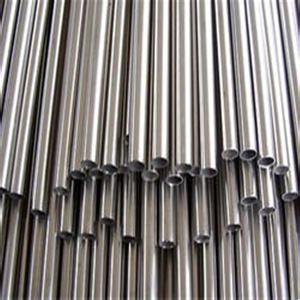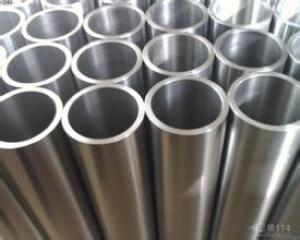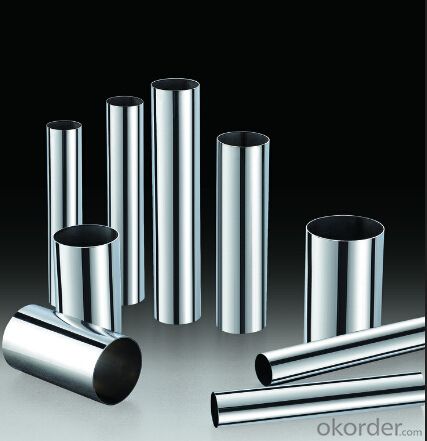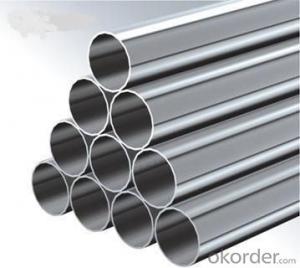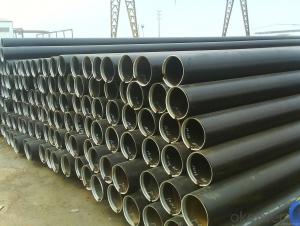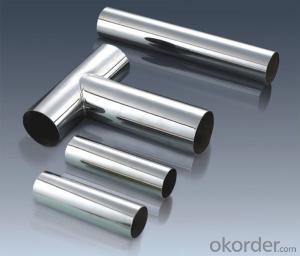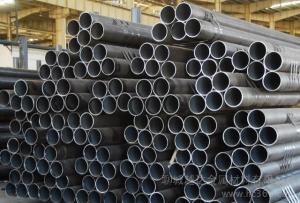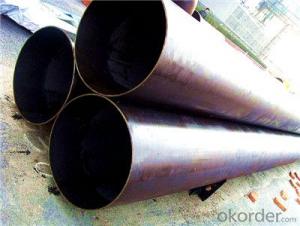Stainless Seamless Steel Pipes With High Quality
- Loading Port:
- China main port
- Payment Terms:
- TT or LC
- Min Order Qty:
- 100 m.t.
- Supply Capability:
- 10000 m.t./month
OKorder Service Pledge
OKorder Financial Service
You Might Also Like
1、Structure of Seamless Pipe :
Seamless pipe is formed by drawing a solid billet over a piercing rod to create the hollow shell and it is regarded as withstanding pressure better than other types, and was often more easily available than welded pipe.
2、Main Features of the Seamless Pipe :
• High manufacturing accuracy
• High strength
• Good visual effect
• Reasonable price
3、Seamless Pipe Specification:
Standard | GB, DIN, ASTM ASTM A106-2006, ASTM A53-2007 |
Grade | 10#-45#, 16Mn 10#, 20#, 45#, 16Mn |
Thickness | 8 - 33 mm |
Section Shape | Round |
Outer Diameter | 133 - 219 mm |
Place of Origin | Shandong, China (Mainland) |
Secondary Or Not | Non-secondary |
Application | Hydraulic Pipe |
Technique | Cold Drawn |
Certification | API |
Surface Treatment | factory state or painted black |
Special Pipe | API Pipe |
Alloy Or Not | Non-alloy |
Length | 5-12M |
Outer Diameter | 21.3-610mm |
Grade | 20#, 45#, Q345, API J55, API K55, API L80, API N80, API P110, A53B |
Standard | ASME, ASTM |
4、Packaging & Delivery of Seamless Pipe
Packaging Details: | seaworthy package,bundles wrapped with strong steel strip |
Delivery Detail: | 15-30days after received 30%TT |
5、FAQ of Seamless Pipe:
①How is the quality of your products?
Our products are manufactured strictly according to national and internaional standard, and we take a test on every pipe before delivered out. If you want see our quality certifications and all kinds of testing report, please just ask us for it.
Guaranteed: If products’ quality don’t accord to discription as we give or the promise before you place order, we promise 100% refund.
②How about price?
We quote as lowest as possible for any customer, and discount can be given according to quantity”,if you like bargain and factory price is not low enough as you think, just don’t waste your time.Please trust the quotation we would give you, it is professional one.
③Why should you chose us?
Our service formula: good quality+good price+good service=customer’s trust
SGS test is available, customer inspection before shipping is welcome, third party inspection is no problem.
Any question, pls feel free to contact us !
6、Seamless Pipe ASTM A106/53 Images:
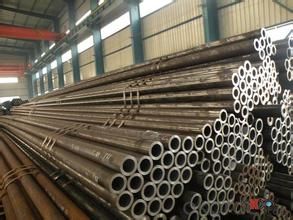
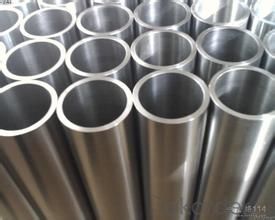
- Q: Are stainless steel pipes suitable for air conditioning systems?
- Yes, stainless steel pipes are suitable for air conditioning systems. They offer excellent corrosion resistance, durability, and can withstand high temperatures and pressure levels commonly found in air conditioning systems. Stainless steel pipes also ensure clean air quality and are easy to maintain, making them a reliable choice for air conditioning installations.
- Q: Can stainless steel pipes be used for exhaust systems?
- Yes, stainless steel pipes can be used for exhaust systems. They are commonly used due to their excellent corrosion resistance, high temperature tolerance, and durability. Stainless steel pipes can withstand the harsh conditions of exhaust gases and provide a long-lasting and efficient solution for exhaust systems.
- Q: Can stainless steel pipes be annealed?
- Stainless steel pipes possess the capability to undergo annealing, a process involving the heating of these pipes to a specific temperature, followed by a gradual cooling, which effectively alleviates stress, enhances ductility, and improves the mechanical properties of the material. Throughout the annealing process, the stainless steel pipes are heated to a temperature surpassing their recrystallization point, typically ranging from 1040°C to 1120°C (1904°F to 2048°F) for austenitic stainless steels. Consequently, this permits the internal structure of the pipes to achieve greater uniformity, thus relieving any stresses that may have been incurred during manufacturing or prior usage. Subsequently, post-annealing, the stainless steel pipes will exhibit improved formability, heightened toughness, and reduced hardness, rendering them suitable for a diverse range of applications across industries such as oil and gas, chemical processing, and construction.
- Q: Can stainless steel pipes be insulated with polystyrene?
- Yes, stainless steel pipes can be insulated with polystyrene. Polystyrene is a commonly used insulation material due to its thermal properties and ability to resist moisture. It can effectively reduce heat transfer and prevent condensation on the surface of the pipe. However, it is important to ensure that the polystyrene insulation is properly sealed and protected to avoid any degradation or damage to the stainless steel pipe.
- Q: Can stainless steel pipes be used in the aerospace industry?
- Yes, stainless steel pipes can be used in the aerospace industry. Stainless steel is known for its high strength, corrosion resistance, and durability, making it suitable for various applications in aerospace such as fuel systems, hydraulic systems, and exhaust systems. Its ability to withstand extreme temperatures and pressure fluctuations makes it an ideal choice for aerospace engineering. Additionally, stainless steel's lightweight nature contributes to fuel efficiency and enhances overall performance in the aerospace industry.
- Q: What is the difference between stainless steel pipes and carbon steel pipes?
- The main difference between stainless steel pipes and carbon steel pipes lies in their composition. Stainless steel pipes contain a higher percentage of chromium, which provides excellent resistance to corrosion and oxidation. On the other hand, carbon steel pipes have a higher carbon content, making them stronger and more durable. Stainless steel pipes are commonly used in applications where corrosion resistance is crucial, such as in the food and chemical industries, while carbon steel pipes are often used for high-pressure and high-temperature applications, such as in oil and gas pipelines.
- Q: What wire is used for welding of 316 stainless steel line?
- Apply A102 (E308-16) or A202 (E316-16) welding rodAttention should be summarized as follows: welding rod should be dry, low current, fast welding speed, interlayer temperature of about 60 degrees, intermittent welding, in order to avoid intergranular corrosion, immediately after welding water cooling.
- Q: Can stainless steel pipes be used for marine applications?
- Yes, stainless steel pipes are commonly used for marine applications due to their high resistance to corrosion and durability in harsh marine environments.
- Q: Are stainless steel pipes suitable for pharmaceutical applications?
- Stainless steel pipes are a great choice for pharmaceutical applications. They are made from a highly durable and corrosion-resistant material that is extensively used in the pharmaceutical industry for a range of purposes, including transporting and storing pharmaceutical products, constructing equipment, and process piping. One of the primary benefits of stainless steel pipes is their ability to resist corrosion, which is crucial in pharmaceutical settings where preventing contamination is of utmost importance. Stainless steel can withstand a wide range of chemicals and aggressive substances, ensuring that the quality and integrity of pharmaceutical products remain intact. Moreover, stainless steel pipes offer excellent hygienic properties. They are easy to clean and sterilize, making them ideal for pharmaceutical applications that require strict cleanliness standards. The smooth and non-porous surfaces of stainless steel pipes have minimal bacterial adhesion, making it simpler to maintain a sterile environment. In addition to their corrosion resistance and hygienic properties, stainless steel pipes are also known for their high strength and durability. They can endure high temperatures and pressures, making them suitable for various pharmaceutical processes. Stainless steel pipes also possess exceptional mechanical properties, such as impact resistance and fatigue strength, ensuring long-lasting performance and minimizing the risk of failures in pharmaceutical applications. Overall, stainless steel pipes are widely utilized in the pharmaceutical industry due to their corrosion resistance, hygienic properties, and durability. They provide a dependable and secure solution for transporting and storing pharmaceutical products while maintaining a clean and sterile environment.
- Q: Can stainless steel pipes be used for food storage facilities?
- Yes, stainless steel pipes can be used for food storage facilities. Stainless steel is highly resistant to corrosion, easy to clean, and non-reactive with food, making it a suitable material for ensuring food safety and hygiene in storage facilities.
Send your message to us
Stainless Seamless Steel Pipes With High Quality
- Loading Port:
- China main port
- Payment Terms:
- TT or LC
- Min Order Qty:
- 100 m.t.
- Supply Capability:
- 10000 m.t./month
OKorder Service Pledge
OKorder Financial Service
Similar products
Hot products
Hot Searches
Related keywords

